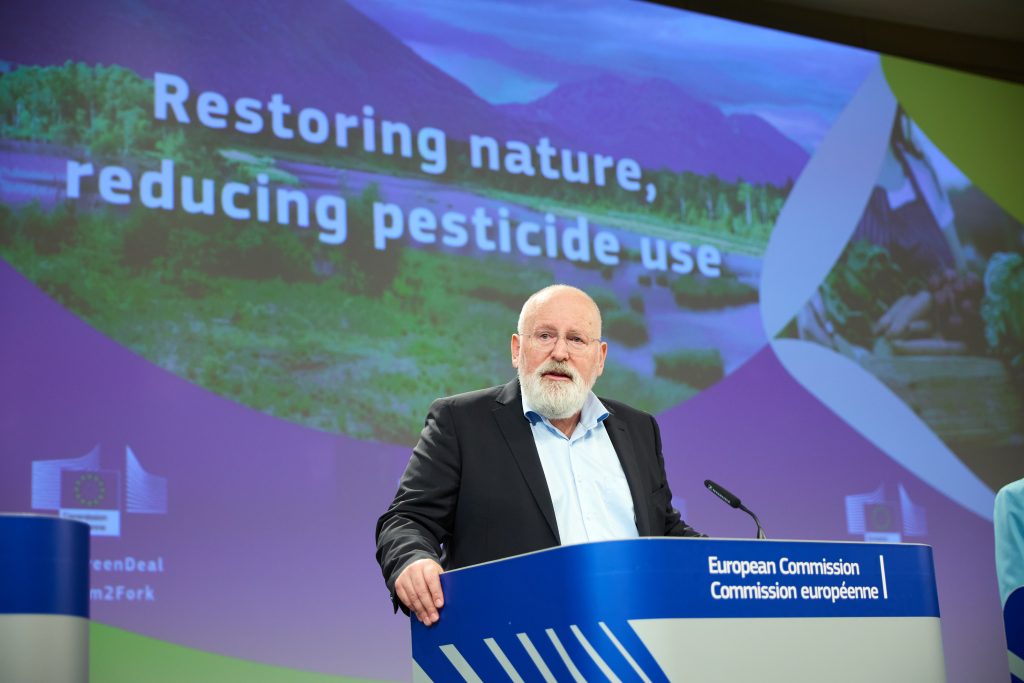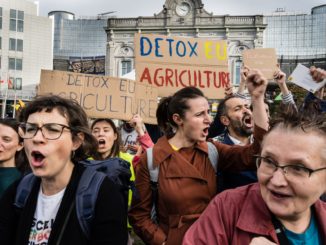
The European Commission today made a tentative step towards addressing the biodiversity crises, with the announcement of a Nature Restoration Law – the first such move since 1992. Ashley Parsons reports.
Presented today by Commissioner Frans Timmerman, the Nature Restoration Law takes aim at restoring the EU’s damaged ecosystems: 80% of the European habitats are in poor condition. This is the first major biodiversity legislation in the EU since the 1992 Habitats Directive, and was announced alongside the Commission’s proposal to halve the use of pesticides by 2030.
(Watch Frans Timmermans present on today’s Nature Restoration Law and on reducing Pesticides by 50% by 2030)
The Nature Restoration Law addresses all ecosystems across Europe, and would create legally binding targets and national plans for the restoration of different ecosystems for every Member State. An overarching objective sees area-based restoration measures on 20% of the EU land and sea area by 2030. In some countries, the law would scale up existing efforts, like those linked to rewilding, replanting forests, creating greener cities, or reducing pollution. It would not necessarily create more protected areas, but would focus on improving all ecosystems, including managed forests and agricultural land.
According to Client Earth “of great importance are the results-based targets for the restoration of agricultural and forest ecosystems. These will oblige Member States to make progress in the recovery of vulnerable species and their habitats in land and seascapes currently overused by intensive practices. Such targets are under extreme pressure by primary sectors wanting to keep their high-impact production activities.”
The law’s purpose is to avoid ecosystem collapse. Politically, the aim is to deliver on part of the Green Deal: the Biodiversity Strategy for 2030 commits Europe to lead by example on reversing biodiversity loss and restoring nature. The biodiversity budget under the Multiannual Financial Framework is around €100 billion, and financing the Nature Restoration Law’s actions will be included in that budget.
Food Security and Biodiversity Targets: BFFs?
Addressing food security directly in his presentation speech, Timmermans said “Farm to Fork some see the war as a perfect excuse to pull the brakes. The arguments are well known: ‘There are too many risks to global food security already. This is not the time.’ If this is not the time, when? Look at our soils – 70% are in bad shape and it already limits food production in certain areas. Look at pollinators – one in three is in decline even though 80% of our crops depend on them.”
The targets in the law by the Commission include:
- Reversing the decline of pollinator populations by 2030 and increasing their populations from there on.
- No net loss of green urban spaces by 2030, a 5% increase by 2050, a minimum of 10% tree canopy cover in every European city, town, and suburb, and net gain of green space that is integrated to buildings and infrastructure.
- In agricultural ecosystems, an overall increase of biodiversity, and a positive trend for grassland butterflies, farmland birds, organic carbon in cropland mineral soils and high-diversity landscape features on agricultural land.
- Restoration and rewetting of drained peatlands under agricultural use and in peat extraction sites,
- In forest ecosystems, overall increase of biodiversity and a positive trend for forest connectivity, deadwood, share of uneven-aged forests, forest birds and stock of organic carbon,
- Restoring marine habitats such as seagrasses or sediment bottoms, and restoring the habitats of iconic marine species such as dolphins and porpoises, sharks and seabirds,
- Removing river barriers so that at least 25 000 km of rivers would be turned into free-flowing rivers by 2030.
Implementation, not Promises
Responses by NGOs have been positive but with caveats.
“Today’s proposals from the European Commission are a leap in the right direction and can help tackle pesticide pollution and kick start together large scale nature restoration across the EU. Our health, wellbeing and ultimately survival depend upon it.” Sergiy Moroz, European Environmental Bureau (EEB)
Sabien Leemans, Senior Biodiversity Policy Officer at WWF European Policy Office said “The restoration law is a huge opportunity to bring nature back before the climate and biodiversity crises spiral completely out of control.”
But nothing’s perfect: the proposed law does not specifically address peatlands, and drained peatlands, which account for 5% of European GHG emissions. Rewetting peatlands could help restore biodiversity and would have a powerful impact on the bloc’s emissions, and therefore should be included explicitly in the law.
“For this law to have teeth, we need to see planning and monitoring, rules for the measures adopted, and consistency with other EU legislation – otherwise the law’s targets will remain just numbers on a page,” says Ioannis Agapakis, at ClientEarth.
Client Earth also expressed concern over
- Common Fisheries Policy deadlock risks making marine restoration targets risk unimplementable and empty in practice.
- Stronger targets on rivers, floodplains and rewetting.
- A more robust compliance architecture for member states.
Pushback in the agribusiness sector regarding the Farm to Fork strategy has been strong and the war in Ukraine provided an opportunity for detractors to push food security concerns as a reason to delay implementation of the strategy. There have been concerns that specific MEPs have parochially pushed for flexibilities for peatlands based on national circumstances. If the Commission can succeed in implementing a Nature Restoration Law that is hard-hitting, legally binding, and transparently monitored, this could be the beginning of a shifting tide. If they can’t, it will be another well-intentioned but poorly performing attempt to say “our hands are clean,” when it comes to the environment.
More from Brussels
Conference on the Future of Europe – Accession, Treaty Change and Rural Perspectives
All Hot Air? An Organic Action Plan without Farm to Fork Targets




